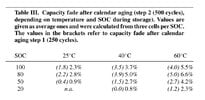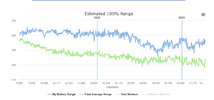If we still simply use the information from the study that is being used as the basis of the calendar aging statements as unquestionably valid, in any case the difference between 55% and 80% SoC for calendar aging at 25C is about ~2%? Not sure that's enough to make a real world difference to me. Besides I like my acceleration just where it is

.
View attachment 988591
Calendar aging is lessening with (the square root of) time, that is only for the first ten months.
If you see it as a 2% only reduction, I offer you another way of looking at it:
For 25C temperature, you will have 2.5% calendar aging instead of 5% for the first 10 months. That means that the calendar aging has been cut in half.
So, the 80% SOC-5% line would at 20% after 16 years, but the 30-55% SOC 2.5% line would be at 10% after 16 years.
Or, 10% after four years versus 5% after four years.
For real world difference in high vs low SOC read the answer below to E90alex.
There is also a lot of research showing that the worst calendar aging is at about SOC = 80%.
Here, cells from a actual model S:

There’s absolutely nothing wrong with using the max recommended daily chargiong level and the argument ”power” is absolutely a valid one.
I did charge my M3P to 55% daily, but I always charged with the max AC power 11kW (230V 16A 3 phase, so equivalndet to L2 48A I guess), and as I always charge late and have the car in the garage the cell temp would be about 30C at the beginning of the drive, giving the car decent power. After it had been parked oputside in the cold winter and driving home arriving at 30% ish, not that much power though.
I changed car to a S Plaid, still charging to 55% but this car can manage the hills even at 55%

Yes and no. There are companies now coming up with standardized ways to measure battery degradation in order to properly value used EVs.
Just like a high mileage and/or abused ICE vehicle is worth less, so could an EV with worse battery degradation. Mileage alone may not be a good indicator of the condition of an EV and its battery.
Yes, I sold my M3P to a company that does business with EV’s only which do battery test all the EV’s.
My 2.5 year old M3P was a early 82.1klWh / 2170L barttery pack car. It had 66K km on the ODO when I sold it.
This company checked my car to 78kWh battery capacity, thats 5% from the 82.1kWh new value, but as more or less no of these batteries reach 82kWh and often start at 80.5kWh the degradation was quite low (492km out of 507km at the latest full charge).
The company (Carla.se) had 4 other cars with the same battery at the same time as mine. Most of them was one year newer and no of the cars had the same ODO number as mine. Mostly about half the miles or less. The degradation test of these cars showed 9-13%.
I now that many here on TMC that saw my low degradation pictures did think most of the difference came from the cold climat we live in here in Sweden but if that was the case I think the other cars would be at 5% as well.
So, my car had half the degradation despite about the double miles driven.(Yes, the miles doesnt matter that much.)

Interresting enough my M3P was still at Carla for a quite long time. The other cars with the same battery and low miles was sold much faster. Maybe multicoat red is not as popular in sweden (not a common color on the M3), otherwise the car was more or less like new. Very well taken care of, so my guess is that people did look At the ODO number and not at the battery degradation report.
Of course, these are still quite new cars and it doesnt matter that much the first 8 years or so, but I guess the world will change about his and the battery health will be more important when we start to se more old cars where the battery breaks down.





